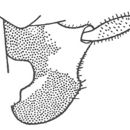en
names in breadcrumbs


Identification: Length 17–26 mm. Male subgenital plate with prominent, ventrally directed process that is not terminally cleft.
Habitat: High altitude sagebrush prairie and open forests of lodgepole pine and subalpine fir.
Season: June–Aug.
Song at 25°C: A succession of short trills consisting of short duration pulses produced at a rate of about 54/s. The carrier frequency is nearly pure and about 13 kHz. Males call at night and stay within a meter of the forest floor. Calling occurs at temperatures as low as 2°C!
Similar species: Cyphoderris monstrosa has the ventrally directed process of male subgenital plate shaped like the nail-pulling claw of a hammer.
More information: family Prophalangopsidae
References: Morris & Gwynne 1978, Mesa & Ferreira 1984, Sakaluk et al. 1987, Morris et al. 1989, Sakaluk & Snedden 1990, Snedden & Sakaluk 1992, Eggert & Sakaluk 1994, Snedden & Irazuzta 1994, Sakaluk et al. 1995, Snedden 1996.
"
"